THE PATTERSONS: AN IRISH FAMILY ODYSSEY
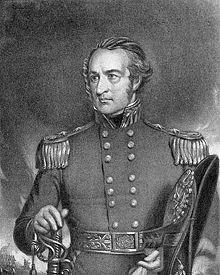
William Marmion on one family’s journey across continents and through Irish and American history in the 19th century.
Major General Robert Patterson (1792 Ireland – 1881 Philadelphia), was a renowned soldier in U.S. service. Prominent in the War of 1812 against the British, he became quite famous during the Mexican War and was one of the seventeen serving Union Generals of Irish birth during the U.S. Civil War.
This article is focused on the odyssey of the family started by his father, Francis, born in County Tyrone in 1765 And the remarkable descents from him and his five children (which includes General Robert and the four children born in the United States).
It is an Irish story, indeed an odyssey, and one which reflects the migrations, trials, and tribulations of many many hundreds of thousands of Irish families which had to leave Ireland for the U.S. for one set of reasons or another. While the greater success of the Pattersons may not be ‘typical’ of the mass of emigrant Irish families, it does typify all the families who indeed struggled to advance themselves in their new country.
Dissenters
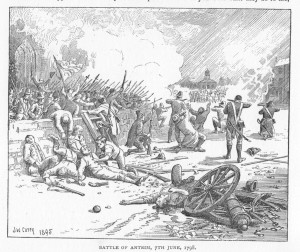
Francis Patterson was the son of Robert and an Ann Fullerton, both born in northern Ireland. ‘Patterson’ is an English name and I find no early references to any Patterson family in Ireland prior to the 17th century. So in all likelihood the Pattersons were part of the wave of English and Scottish Protestants who settled in Ulster in that tumultuous century, some in state sponsored ‘plantations’ and others in unorganised migration.
Despite their origins, many of the ‘planted’ Protestants began to detest the policies of the English government on many levels, and wanted ‘local rights’ versus London control. And especially in the late 18th century, leaders emerged, initially all Protestant, who felt ‘Irish’ and saw the need to unite with all those who had been disenfranchised and made subject to ‘Penal Laws’. These disenfranchised both Catholics and all the ‘dissenters’ (Presbyterians, etc.) who were outside of the ‘official’ Anglican Church of Ireland – which among other things, forbade them from holding public office, owning land over a certain value and which prevented legal recognition of their marriages.
The Patterson odyssey starts in County Tyrone, where they were Presbyterian United Irish radicals who had to flee in the aftermath of the 1798 rebellion.
One such Presbyterian radical was Francis Patterson of County Tyrone, who like many other Presbyterians were attracted to the radical politics of the Society of the United Irishmen. He was thus united with his fellow ‘Irishmen’ in the Rising of 1798 – a bloody but failed revolt which attempted to found an Irish republic but which was ruthlessly crushed after three uncoordinated outbreaks in Leinster Ulster and Connacht in the summer of that year.
While not captured, Francis Patterson obviously was known to be a participant and had a price on his head. What to do? Get out of Ireland before the sheriff arrived, which is exactly what Francis did, along with his wife Ann Graham (born Ireland circa 1772, married to Francis in 1790), and their one child born in Ireland (in County Tyrone) in 1792: the Robert later to be the famous general in the U.S.
There existed networks of people who had previously emigrated, and Francis undoubtedly was absolutely helped in that regard. He came to Pennsylvania and settled there, going into some sort of brokerage of cotton business. It is clear that he knew about fellow Irish people who had emigrated – specifically the Graham family, to whom he was related by marriage.
Indeed one might say that his ‘odyssey’ is really part of the odyssey of the Graham family. Hugh Graham, born County Tyrone in 1784, was the youngest of 10 children of the Graham’s. His family had had their property confiscated, and the father of Hugh, Thomas, and Hugh’s older brothers, were United Irishmen just as Francis was!
Francis’ wife, Nancy Ann Graham (always called just ‘Ann) was an older sister of Hugh Graham. Hugh left Ireland at 14 in 1798-99, the same year as Francis himself left. He went to Claiborne County in East Tennessee, a very sparsely populated region with plenty of land available in a lovely apart of the Cumberland Gap.
In America
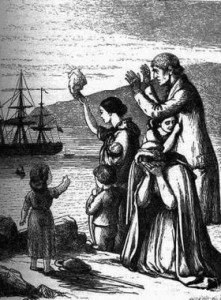
Hugh’s nephew, William Houston, son of another older sister, Mary, came to America with Hugh in 1799. The interactions between the Graham relations of Ann Graham Patterson and her husband Francis and their children are absolutely central to understanding the Irish Odyssey of Francis. Virtually the whole Graham clan eventually came to Claiborne County from Ireland, to include prominently Hugh’s older brother William Graham in 1810 who became closely involved in the business affairs of his brother Hugh and nephew William Houston thereafter.
The whole Graham clan became very wealthy landowners in Claiborne County and, yes, were slaveholders. William Graham married a Chamberlain, and thus the use of that name as a middle name. Many children received as a middle name that of a relative and we will see how ‘Houston’ and ‘Chamberlain’ were so used by the Pattersons and Grahams for various of their children, to include the youngest of General Robert, William Houston Patterson, and William Chamberlain for the youngest son of Francis and Ann Graham Patterson.
The Grahams, in-laws of the Pattersons, had settled in east Tennessee and became wealthy slaveholding landowners. They helped the Pattersons to also settle in this area.
William Graham, an older brother of Hugh and Ann Graham: had been in rebellion with Robert Emmet 1802-03 and as said came to Tennessee in 1810, and went into business with Hugh and his nephew William Houston. William became very wealthy, owned a general store with William Houston as well as extensive farm acreage. He actually went to Richmond and was involved in purchasing slaves to be brought to Tennessee. But, prior to his own death in 1840, William freed his 300 slaves, having previously bought large acreage for them to settle on in free Ohio.
He saw to their transport there with all the implements needed to be successful farmers, and free; and even put up a surety bond with the State of Ohio against their ever becoming a charge to that State. Rather remarkable and shows that not all the Grahams remained steadfast to the ‘peculiar institution’ of slavery. The cost of what William did had to be enormous. Undoubtedly William’s wealth was spread among his Graham relatives at his death (without any children), but his manumission and caring for his former bondsmen is worthy of great note. He didn’t just ‘free’ people, he provided that they would have a future.
Francis Patterson and his wife Ann Graham had three children born in Pennsylvania, James M. in 1799, Mary c. 1800, and Frances Jane in 1806. It would then appear that at about the time of the start of the War of 1812 Francis decided himself to go to live in Claiborne County in Eastern Tennessee, that decision clearly related to the Graham relations of his wife being there. Or perhaps she made the decision for him!; so he purchased a large tract of land and emigrated there.
His last child, William Chamberlain, was born there in 1813 (while the oldest son Robert was in the army fighting the British, and beginning to build his reputation as a soldier, mustering out in 1815 as a Lieutenant Colonel, and having received a ‘regular’ army commission as well during his service). Mary the oldest daughter married her cousin William Houston in Tennessee circa 1825 (no children but much ’fostering’ of various nephews and nieces as will be mentioned later).
Francis stayed on permanently in Tennessee though documented as making trips back to Pennsylvania. We know that son Robert took over the business dealings in Philadelphia. On that front Robert built his business to the point of becoming a millionaire by the time of the Mexican War mid-1840’s. And we know that Francis’ youngest son William C. born in Tennessee went to Philadelphia to work with Robert, and stayed there for the rest of his life. More on William Chamberlain later.
William Graham a lifelong slave-owner, freed his slaves shortly before his death and paid for them to live in the free State of Ohio.
Francis died in 1845, but well before that strong connections were also made with the prestigious, wealthy and influential Fulkerson family of East Tennessee and Lee County, Western Virginia – all in the Cumberland Gap area. Peter Fulkerson (1764-1847) had a total of ten children, and one, Dr. James, became the husband of Francis’ daughter Frances J., in 1832. And another of his children, Margaret, became the wife of Francis’ son James M. This is documented as happening in 1832 in Lee County, Virginia.
This was probably a ‘double wedding’ of sister and brother to sister and brother! All then living in Claiborne County, Tennessee for their lives! And parenting many children which I will also cover – for their story is part of the military conflict of the Civil War. Families in Tennessee ended up fighting on opposite sides and the Pattersons were one such family.
Robert Patterson: American Soldier
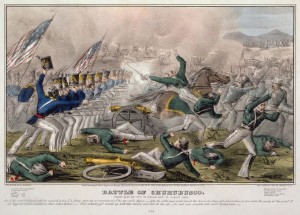
Robert Patterson of Philadelphia, War of 1812 veteran, volunteered for the colours for the Mexican War, and indeed he performed conspicuously gallant service. He rose to be Major General of U.S. Volunteers, in charge by war’s end of all the volunteer regiments/brigades.
He was one of the heroes of the war. Mustered out, he started the to be very prestigious ‘Aztec Club’, based in Philadelphia and limited to all officers who served in Mexico, as an hereditary society. He remained active in that endeavour until his death, being President of the club – which kept him in contact with all the major military figures who were members.
Robert Patterson, a first generation Ulster Scots immigrant became a prominent US soldier and served in the War of 1812, the Mexican American War and as a Major General in the Union Army in the Civil War.
Summoned to active duty again for the Civil War, one of the oldest for field command at age almost 70, he won a few small skirmishes in the Shenandoah Valley as Major General of Volunteers. But was severely criticised for not supporting properly during the First Battle of Bull Run. Robert left the army and was never asked back, in July 1861, at the time of the termination of service for the ‘3 month’ Pennsylvania troops which were within his command.
He wrote a book published in 1865, justifying his record. And continued with his business and Aztec Club activities right up to his death in 1881 at close to 90 years of age! Whatever his error in the Civil War, he remained in high regard for his life’s work. At his Presbyterian funeral, his pallbearers ex-President General Grant, then General-of-the-Army General Sherman, and Generals Porter and Hancock, as well as there being attendance by numerous other generals and by many of the top political and business echelon of the United States. An impressive sendoff for a boy born in County Tyrone who escaped to the U.S. with his fleeing father in 1798-99!
Now turning to his brother William Chamberlain, born Tennessee 1813 but who went back to work with Robert in Pennsylvania: he was not only in the family business but he also became the 2nd President of the Pennsylvania Railroad and altogether had a most prosperous career. He died in 1883, much praised also but for his civilian accomplishments and not for anything military. He had married Caroline Ellmaker, born 1816 in Pennsylvania, and had 6 children, 3 boys and 3 girls.
He was referred to later in life as ‘Colonel’ but there does not appear to a record active Civil War service for him, so most probably that was from some service in a militia regiment which was not called up. No Civil War service noted for the sons of William Chamberlain, whose own middle name reflected the surname of the wife of his uncle William Graham (died 1840, previously discussed).
As stated previously, James M., the brother born 1799 in Pennsylvania, stayed on forever in Tennessee, and died in 1883. He as said had married Margaret Fulkerson. They had 6 children, 4 of whom were boys. Likewise his sister Frances Jane lived her life in Claiborne County from the first emigration of her father Francis and mother Ann Graham, being married to Dr. James Fulkerson (who died relatively young in 1859, prior to the start of the Civil War).
Frances J. (‘Fanny’) was born in 1806 and still alive at the Census of 1880 with some adult children living with her. She and her husband had had a total of 8 children, 6 boys. It was mentioned that James M’s and Frances’ older sister, Mary, had married her cousin William Houston and lived her life in Claiborne County also, but left no children.
A family divided by Civil War
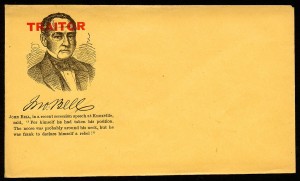
Let us turn now more specifically to the descents from five children of Francis Patterson and Ann Graham Patterson. Firstly, it is obvious that there was strong intercourse between the branches of the family in Philadelphia (Robert and William Chamberlain) and those in Tennessee (Mary, James M. and Frances J.). Clearly there was much travel both ways, visits, etc. from 1815 until the start of the Civil War (with a few of the Tennessee children actually working in the Philadelphia business – nephews of Robert and William C.). Let me start with a digression to explain the situation ‘on the ground’ in East Tennessee at the beginning of the Civil War.
While Robert Patterson served as a senior officer in the Union army, the Grahams, his cousins, were diehard Confederates.
That part of Tennessee had voted for Abraham Lincoln, and remained strongly unionist in general. But there were many Confederates as well of course, with military formations formed for service in the Confederate army. It was a major objective of President Lincoln to control East Tennessee after the larger portion of the state was captured early in the war. But the ‘rebs’ held on until after the battle of Chickamauga in September 1863, and it wasn’t until January 1864 that East Tennessee was freed from Confederate control. While the area was strongly unionist in general, there was as said a not insignificant number of ‘secessionists’.
And these included mainly those of the wealthier class. And those in Claiborne County were the Grahams and Fulkersons, all related to Francis Patterson and his wife Ann Graham. Ann’s brother Hugh, the 1798 emigrant from Ireland was indeed extremely wealthy and his home was the ‘showcase’ mansion of the county, shades of ‘Tara’ in Gone With The Wind.
Used as a headquarters for the Confederates, after the occupation by the Yanks it served that purpose for them as well. Hugh Graham had died in 1863 having sired seven lovely daughters and brought them up with a classical education and with much ‘courtly’ refinement – a history covered in several books and only mentioned here to complete the situation ‘on the ground’ for the Pattersons in East Tennessee.
It should finally be pointed out that the Civil War from the ‘Yank’ viewpoint was one to ‘save the Union’, and from the ‘Reb’ viewpoint to safeguard ‘States Rights’. Lincoln stressed that it was about the indissolubility of the union, and not as a battle against slavery as such or even for the freedom of the slaves (though by 1863 with the Emancipation Proclamation the slaves were all eventually freed). The overwhelming number of southerners who fought and died for the Confederacy were non-slave-owners, and were fighting for ‘local’ rights.
On either side, in short, the vast numbers who fought would never have rallied to the colours on either side if the war was presented as fundamentally for or against slavery. The Grahams and Pattersons in Tennessee, having fought for ‘local’ rights in Ireland, were by disposition in favour of the same in the U.S. and while slaveholders those who went ‘with their state’ did so for ‘States Rights’. While others in the family who went with the Union did so because of belief in the permanency of the ‘United’ States as ‘the’ issue.
In terms of actual service, three sons and a son-in-law of our General Robert Patterson served on the Union side during the Civil War, to include three being generals, two of whom were West Point graduates. And he had eight nephews who served with distinction in the Confederate Army – to include several receiving battle honours/wounds and one being killed in action. The nephews were the sons of Robert’s sister Frances and brother James M.
Conclusion
Francis Patterson and his wife Ann Graham Patterson wound up having a total of 27 grandchildren. This paper has not gone into any detail about the marriages and children of the grandchildren (the great-grandchildren had to number close to 100)! There are many many descendants today and they can point back to a most interesting family odyssey, all started by the escape from Ireland by Francis Patterson, United Irishman!
by Chevalier William F.K. Marmion, M.A.
Main Sources
T. Pakenham, The Year of Liberty: the Great Irish Rebellion
of 1798 (1969)
W.E.H. Lecky, History of Ireland in the 18th Century (1881)
Lt Col M.M. Boatner, US Army, The Civil War Dictionary (1959)
Life of General Robert Patterson, Wikipedia article on the
internet
Civil War Records of Tennessee Confederate Soldiers 1861-65,
available on the internet
Robert Patterson complete family history on Find A Grave
website, plus various obituaries of General Patterson from
a number of Philadelphia and Washington D.C. newspapers
U.S. Census Reports, 1820 to 1870, for Pennsylvania and
Tennessee
S. Cottrell, Civil War in Tennessee (2002)
O. Temple, East Tennessee and the Civil War (1899)